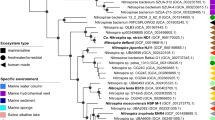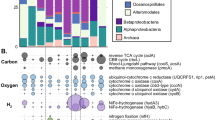Abstract
Beneath Australia’s large, dry Nullarbor Plain lies an extensive underwater cave system, where dense microbial communities known as ‘slime curtains’ are found. These communities exist in isolation from photosynthetically derived carbon and are presumed to be chemoautotrophic. Earlier work found high levels of nitrite and nitrate in the cave waters and a high relative abundance of Nitrospirae in bacterial 16S rRNA clone libraries. This suggested that these communities may be supported by nitrite oxidation, however, details of the inorganic nitrogen cycling in these communities remained unclear. Here we report analysis of 16S rRNA amplicon and metagenomic sequence data from the Weebubbie cave slime curtain community. The microbial community is comprised of a diverse assortment of bacterial and archaeal genera, including an abundant population of Thaumarchaeota. Sufficient thaumarchaeotal sequence was recovered to enable a partial genome sequence to be assembled, which showed considerable synteny with the corresponding regions in the genome of the autotrophic ammonia oxidiser Nitrosopumilus maritimus SCM1. This partial genome sequence, contained regions with high sequence identity to the ammonia mono-oxygenase operon and carbon fixing 3-hydroxypropionate/4-hydroxybutyrate cycle genes of N. maritimus SCM1. Additionally, the community, as a whole, included genes encoding key enzymes for inorganic nitrogen transformations, including nitrification and denitrification. We propose that the Weebubbie slime curtain community represents a distinctive microbial ecosystem, in which primary productivity is due to the combined activity of archaeal ammonia-oxidisers and bacterial nitrite oxidisers.
Similar content being viewed by others
Log in or create a free account to read this content
Gain free access to this article, as well as selected content from this journal and more on nature.com
or
References
Bartossek R, Spang A, Weidler G, Lanzen A, Schleper C . (2012). Metagenomic analysis of ammonia-oxidizing archaea affiliated with the soil group. Front Microbiol 3: 208.
Bates ST, Berg-Lyons D, Caporaso JG, Walters WA, Knight R, Fierer N . (2011). Examining the global distribution of dominant archaeal populations in soil. ISME J 5: 908–917.
Blainey PC, Mosier AC, Potanina A, Francis CA, Quake SR . (2011). Genome of a low-salinity ammonia-oxidizing archaeon determined by single-cell and metagenomic analysis. PLoS One 6: e16626.
Brady A, Salzberg SL . (2009). Phymm and PhymmBL: metagenomic phylogenetic classification with interpolated Markov models. Nat Methods 6: 673–676.
Caffrey JM, Bano N, Kalanetra K, Hollibaugh JT . (2007). Ammonia oxidation and ammonia-oxidizing bacteria and archaea from estuaries with differing histories of hypoxia. ISME J 1: 660–662.
Caporaso JG, Kuczynski J, Stombaugh J, Bittinger K, Bushman FD, Costello EK et al (2010). QIIME allows analysis of high-throughput community sequencing data. Nat Methods 7: 335–336.
Cole JR, Chai B, Farris RJ, Wang Q, Kulam SA, McGarrell DM et al (2005). The Ribosomal Database Project (RDP-II): sequences and tools for high-throughput rRNA analysis. Nucleic Acids Res 33: D294–D296.
Darling AE, Mau B, Perna NT . (2010). progressiveMauve: multiple genome alignment with gene gain, loss and rearrangement. PLoS One 5: e11147.
Darriba D, Taboada GL, Doallo R, Posada D . (2012). jModelTest 2: more models, new heuristics and parallel computing. Nat Methods 9: 772.
Erguder TH, Boon N, Wittebolle L, Marzorati M, Verstraete W . (2009). Environmental factors shaping the ecological niches of ammonia-oxidizing archaea. FEMS Microbiol Rev 33: 855–869.
Gillieson DS, Spate AS . (1992). The nullarbor karst. In: Gillieson DS (ed). Geology, climate, hydrology and karst formation: IGCP Project 299, Field symposium. Department of Geography and Oceanography, Australian Defense Force Academy Special Publication edn: Canberra, pp 65–99.
Guindon S, Dufayard JF, Lefort V, Anisimova M, Hordijk W, Gascuel O . (2010). New algorithms and methods to estimate maximum-likelihood phylogenies: assessing the performance of PhyML 3.0. Syst Botany 5: 307–321.
Hallam SJ, Konstantinidis KT, Putnam N, Schleper C, Watanabe Y, Sugahara J et al (2006). Genomic analysis of the uncultivated marine crenarchaeote Cenarchaeum symbiosum. Proc Natl Acad Sci USA 103: 18296–18301.
Holmes AJ, Tujula NA, Holley M, Contos A, James JM, Rogers P et al (2001). Phylogenetic structure of unusual aquatic microbial formations in Nullarbor caves, Australia. Env Microbiol 3: 256–264.
James J, Rogers P . (1994). The ‘mysterious’ calcite precipitating organism of the Nullarbor caves, Australia. In: Sasowsky ID, Palmer M (eds). Breakthroughs in karst geomicrobiology and redox geochemistry. Karst Waters Institute Special Publication 1: Charlestown, pp 34–35.
Margulies M, Egholm M, Altman WE, Attiya S, Bader JS, Bemben LA et al (2005). Genome sequencing in microfabricated high-density picolitre reactors. Nature 437: 376–380.
Martin-Cuadrado AB, Rodriguez-Valera F, Moreira D, Alba JC, Ivars-Martinez E, Henn MR et al (2008). Hindsight in the relative abundance, metabolic potential and genome dynamics of uncultivated marine archaea from comparative metagenomic analyses of bathypelagic plankton of different oceanic regions. ISME J 2: 865–886.
Meyer F, Paarmann D, D'Souza M, Olson R, Glass EM, Kubal M et al (2008). The metagenomics RAST server—a public resource for the automatic phylogenetic and functional analysis of metagenomes. BMC Bioinformatics 9: 386.
Muller F, Brissac T, Le Bris N, Felbeck H, Gros O . (2010). First description of giant Archaea (Thaumarchaeota) associated with putative bacterial ectosymbionts in a sulfidic marine habitat. Env Microbiol 12: 2371–2383.
Preston CM, Wu KY, Molinski TF, DeLong EF . (1996). A psychrophilic crenarchaeon inhabits a marine sponge: Cenarchaeum symbiosum gen. nov., sp. nov. Proc Natl Acad Sci USA 93: 6241–6246.
Richards AM . (1971). An ecological study of the cavernicolous fauna of the Nullarbor Plain Southern Australia. J Zool, Lond 164: 1–60.
Schloss PD, Westcott SL, Ryabin T, Hall JR, Hartmann M, Hollister EB et al (2009). Introducing mothur: open-source, platform-independent, community-supported software for describing and comparing microbial communities. Appl Environ Microbiol 75: 7537–7541.
Tully BJ, Nelson WC, Heidelberg JF . (2012). Metagenomic analysis of a complex marine planktonic thaumarchaeal community from the Gulf of Maine. Environ Microbiol 14: 254–267.
Walker CB, de la Torre JR, Klotz MG, Urakawa H, Pinel N, Arp DJ et al (2010). Nitrosopumilus maritimus genome reveals unique mechanisms for nitrification and autotrophy in globally distributed marine crenarchaea. Proc Natl Acad Sci USA 107: 8818–8823.
Webb JA, James JM . (2006). Karst evolution of the Nullarbor Plain, Australia. In: Harmon RS, Wicks CM (eds). Karst Geomorphology, Hydrology And Geochemistry. Geological Society of America Special Paper 404: Boulder, pp 65–78.
Wuchter C, Abbas B, Coolen MJ, Herfort L, van Bleijswijk J, Timmers P et al (2006). Archaeal nitrification in the ocean. Proc Natl Acad Sci USA 103: 12317–12322.
Acknowledgements
ITP received support from a Life Science Research Award, provided by the New South Wales Office of Science and Medical Research. We would also like to acknowledge the cave divers responsible for sample collection and photography: Peter Rogers, Cheryl Bass, Bob Davis, Phil Prust and Steve Trewavas.
Author information
Authors and Affiliations
Corresponding author
Additional information
Supplementary Information accompanies the paper on The ISME Journal website
Rights and permissions
About this article
Cite this article
Tetu, S., Breakwell, K., Elbourne, L. et al. Life in the dark: metagenomic evidence that a microbial slime community is driven by inorganic nitrogen metabolism. ISME J 7, 1227–1236 (2013). https://doi.org/10.1038/ismej.2013.14
Received:
Revised:
Accepted:
Published:
Issue date:
DOI: https://doi.org/10.1038/ismej.2013.14
Keywords
This article is cited by
-
Cultivable microbial diversity in speleothems using MALDI-TOF spectrometry and DNA sequencing from Krem Soitan, Krem Lawbah, Krem Mawpun, Khasi Hills, Meghalaya, India
Archives of Microbiology (2022)
-
In situ modelling of biofilm formation in a hydrothermal spring cave
Scientific Reports (2020)
-
Microbial diversity and biosignatures of amorphous silica deposits in orthoquartzite caves
Scientific Reports (2018)
-
DNA-SIP Reveals the Diversity of Chemolithoautotrophic Bacteria Inhabiting Three Different Soil Types in Typical Karst Rocky Desertification Ecosystems in Southwest China
Microbial Ecology (2018)
-
Selective Isolation of a Eucalyptus spp. Woodchip Bacterial Community and Its Taxonomic and Metabolic Profiling
BioEnergy Research (2017)



